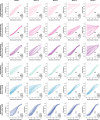Habit formation of preventive behaviours during the COVID-19 pandemic: a longitudinal study of physical distancing and hand washing
- PMID: 35987602
- PMCID: PMC9392502
- DOI: 10.1186/s12889-022-13977-1
Habit formation of preventive behaviours during the COVID-19 pandemic: a longitudinal study of physical distancing and hand washing
Abstract
Background: Since the outbreak of the COVID-19 pandemic, physical distancing and hand washing have been used as effective means to reduce virus transmission in the Netherlands. However, these measures pose a societal challenge as they require people to change their customary behaviours in various contexts. The science of habit formation is potentially useful for informing policy-making in public health, but the current literature largely overlooked the role of habit in predicting and explaining these preventive behaviours. Our research aimed to describe habit formation processes of physical distancing and hand washing and to estimate the influences of habit strength and intention on behavioural adherence.
Methods: A longitudinal survey was conducted between July and November 2020 on a representative Dutch sample (n = 800). Respondents reported their intentions, habit strengths, and adherence regarding six context-specific preventive behaviours on a weekly basis. Temporal developments of the measured variables were visualized, quantified, and mapped onto five distinct phases of the pandemic. Regression models were used to test the effects of intention, habit strength, and their interaction on behavioural adherence.
Results: Dutch respondents generally had strong intentions to adhere to all preventive measures and their adherence rates were between 70% and 90%. They also self-reported to experience their behaviours as more automatic over time, and this increasing trend in habit strength was more evident for physical-distancing than for hand washing behaviours. For all six behaviours, both intention and habit strength predicted subsequent adherence (all ps < 2e-16). In addition, the predictive power of intention decreased over time and was weaker for respondents with strong habits for physical distancing when visiting supermarkets (B = -0.63, p <.0001) and having guests at home (B = -0.54, p <.0001) in the later phases of the study, but not for hand washing.
Conclusions: People's adaptations to physical-distancing and hand washing measures involve both intentional and habitual processes. For public health management, our findings highlight the importance of using contextual cues to promote habit formation, especially for maintaining physical-distancing practices. For habit theories, our study provides a unique dataset that covers multiple health behaviours in a critical real-world setting.
Keywords: COVID-19; Habit formation; Habit-intention interaction; Longitudinal study; Personal hygiene; Physical distancing; Preventive behavior.
© 2022. The Author(s).
Conflict of interest statement
The authors declare that they have no competing interests.
Figures






References
-
- World Health Organization and others. Pandemic influenza preparedness and mitigation in refugee and displaced populations: Who guidelines for humanitarian agencies. Technical report, World Health Organization. 2008.
-
- Michie S, West R. Behaviour change theory and evidence: a presentation to government. Health Psychol Rev. 2013;7(1):1–22. doi: 10.1080/17437199.2011.649445. - DOI
Publication types
MeSH terms
LinkOut - more resources
Full Text Sources
Medical

